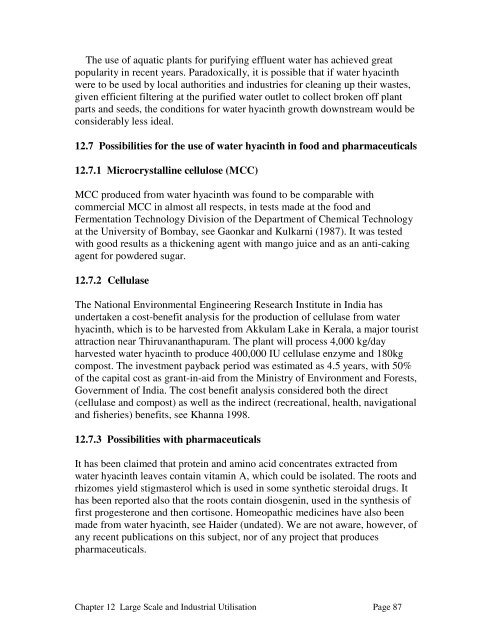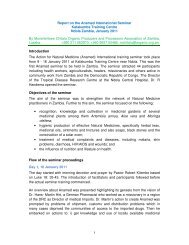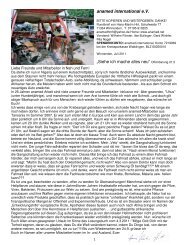Chapter 12 Large-scale and Industrial Utilisation - Anamed
Chapter 12 Large-scale and Industrial Utilisation - Anamed
Chapter 12 Large-scale and Industrial Utilisation - Anamed
You also want an ePaper? Increase the reach of your titles
YUMPU automatically turns print PDFs into web optimized ePapers that Google loves.
The use of aquatic plants for purifying effluent water has achieved great<br />
popularity in recent years. Paradoxically, it is possible that if water hyacinth<br />
were to be used by local authorities <strong>and</strong> industries for cleaning up their wastes,<br />
given efficient filtering at the purified water outlet to collect broken off plant<br />
parts <strong>and</strong> seeds, the conditions for water hyacinth growth downstream would be<br />
considerably less ideal.<br />
<strong>12</strong>.7 Possibilities for the use of water hyacinth in food <strong>and</strong> pharmaceuticals<br />
<strong>12</strong>.7.1 Microcrystalline cellulose (MCC)<br />
MCC produced from water hyacinth was found to be comparable with<br />
commercial MCC in almost all respects, in tests made at the food <strong>and</strong><br />
Fermentation Technology Division of the Department of Chemical Technology<br />
at the University of Bombay, see Gaonkar <strong>and</strong> Kulkarni (1987). It was tested<br />
with good results as a thickening agent with mango juice <strong>and</strong> as an anti-caking<br />
agent for powdered sugar.<br />
<strong>12</strong>.7.2 Cellulase<br />
The National Environmental Engineering Research Institute in India has<br />
undertaken a cost-benefit analysis for the production of cellulase from water<br />
hyacinth, which is to be harvested from Akkulam Lake in Kerala, a major tourist<br />
attraction near Thiruvananthapuram. The plant will process 4,000 kg/day<br />
harvested water hyacinth to produce 400,000 IU cellulase enzyme <strong>and</strong> 180kg<br />
compost. The investment payback period was estimated as 4.5 years, with 50%<br />
of the capital cost as grant-in-aid from the Ministry of Environment <strong>and</strong> Forests,<br />
Government of India. The cost benefit analysis considered both the direct<br />
(cellulase <strong>and</strong> compost) as well as the indirect (recreational, health, navigational<br />
<strong>and</strong> fisheries) benefits, see Khanna 1998.<br />
<strong>12</strong>.7.3 Possibilities with pharmaceuticals<br />
It has been claimed that protein <strong>and</strong> amino acid concentrates extracted from<br />
water hyacinth leaves contain vitamin A, which could be isolated. The roots <strong>and</strong><br />
rhizomes yield stigmasterol which is used in some synthetic steroidal drugs. It<br />
has been reported also that the roots contain diosgenin, used in the synthesis of<br />
first progesterone <strong>and</strong> then cortisone. Homeopathic medicines have also been<br />
made from water hyacinth, see Haider (undated). We are not aware, however, of<br />
any recent publications on this subject, nor of any project that produces<br />
pharmaceuticals.<br />
<strong>Chapter</strong> <strong>12</strong> <strong>Large</strong> Scale <strong>and</strong> <strong>Industrial</strong> <strong>Utilisation</strong> Page 87






